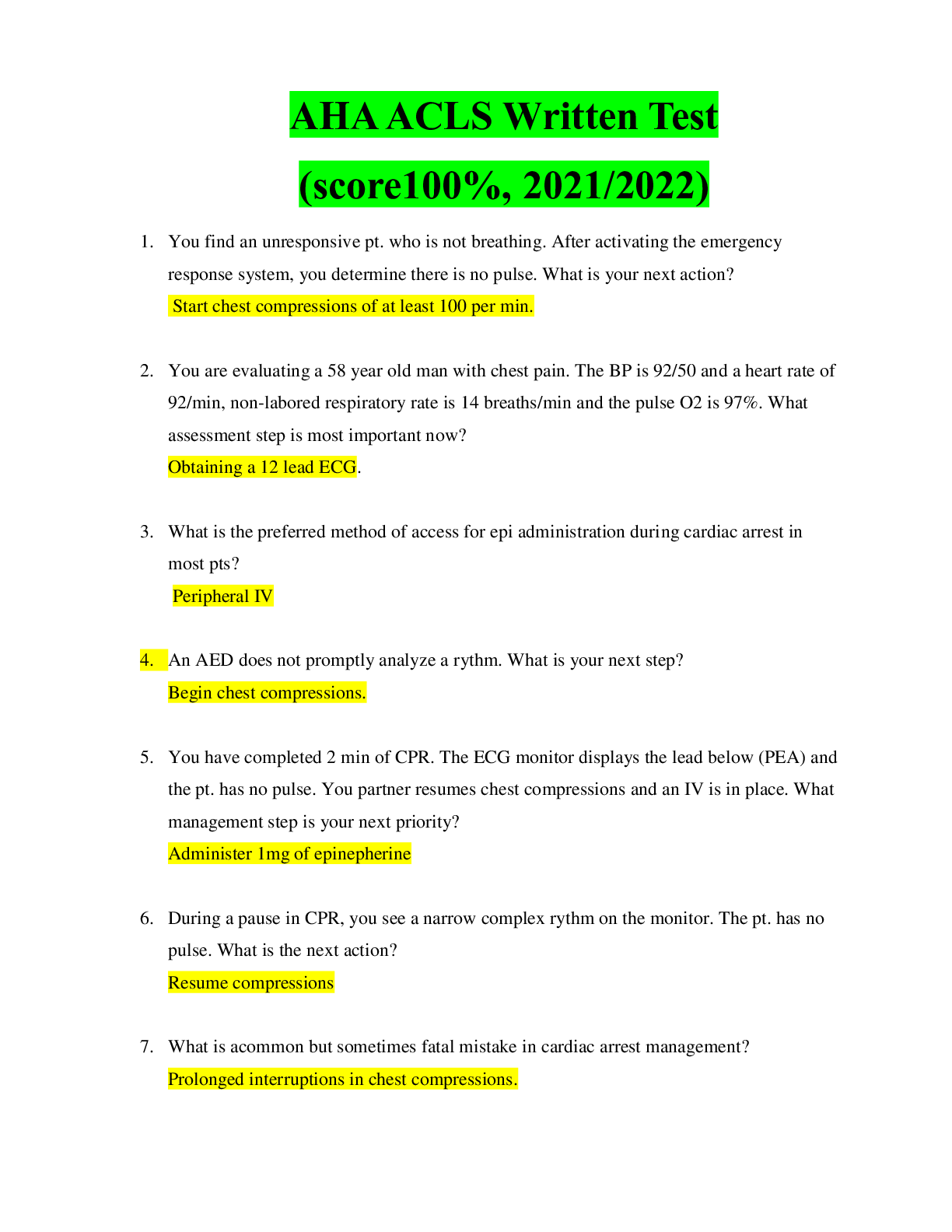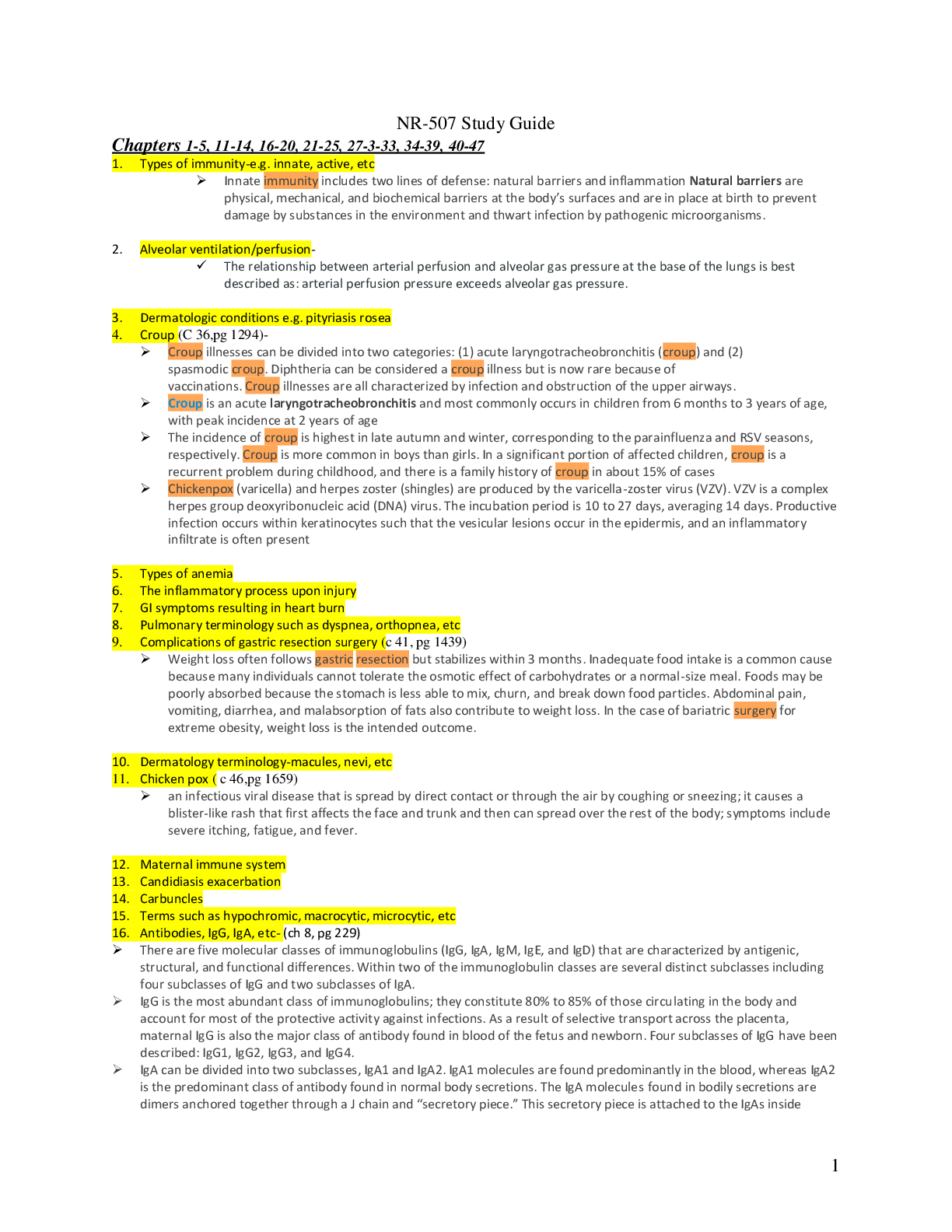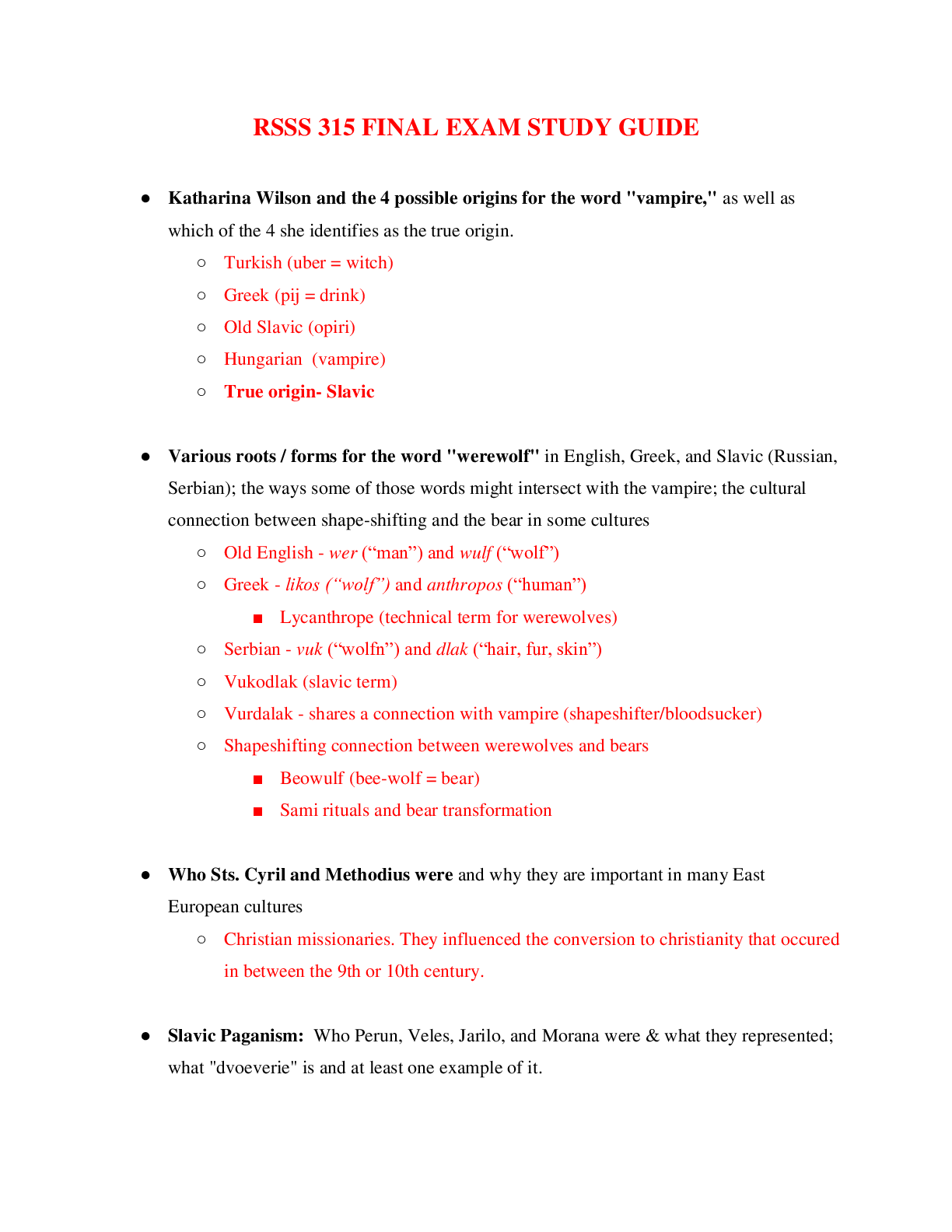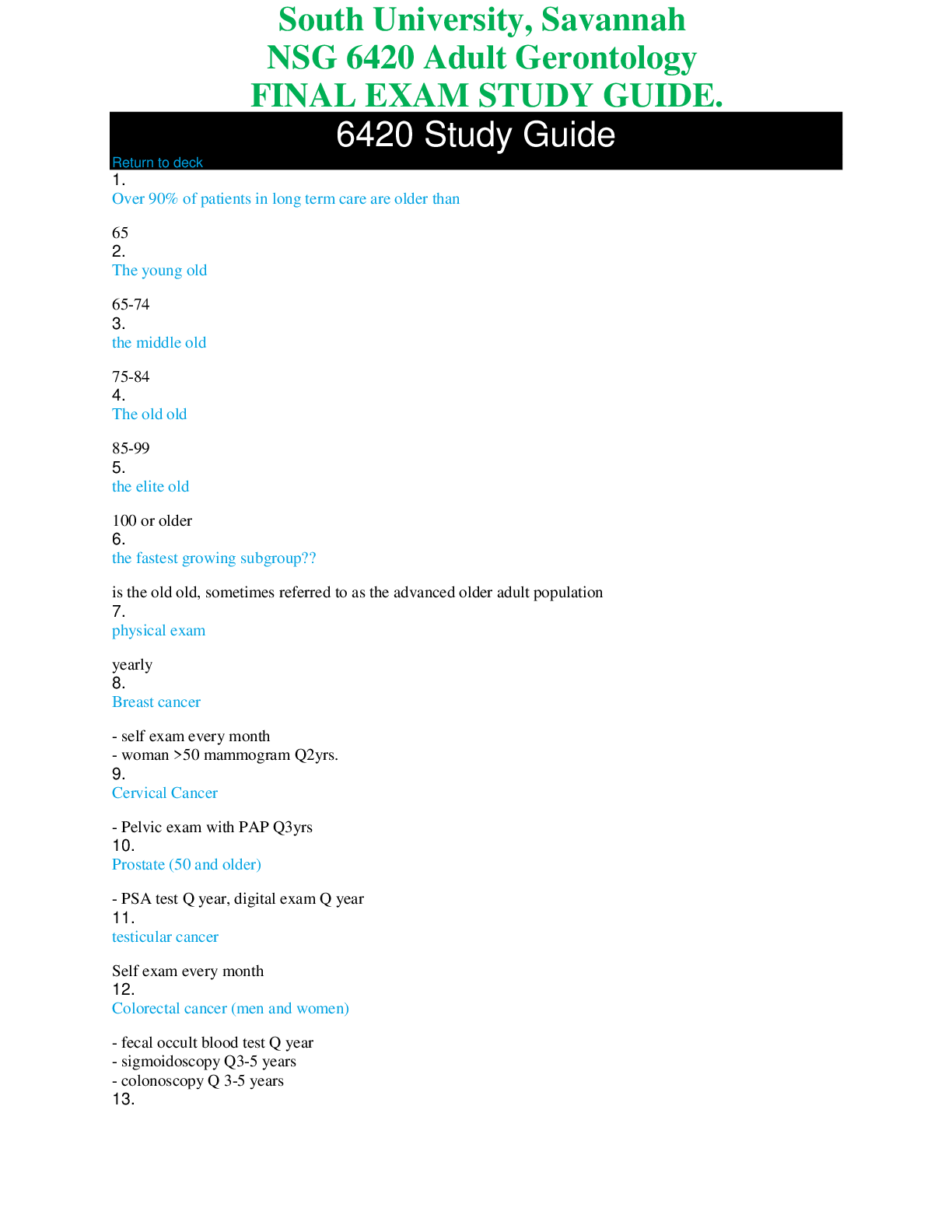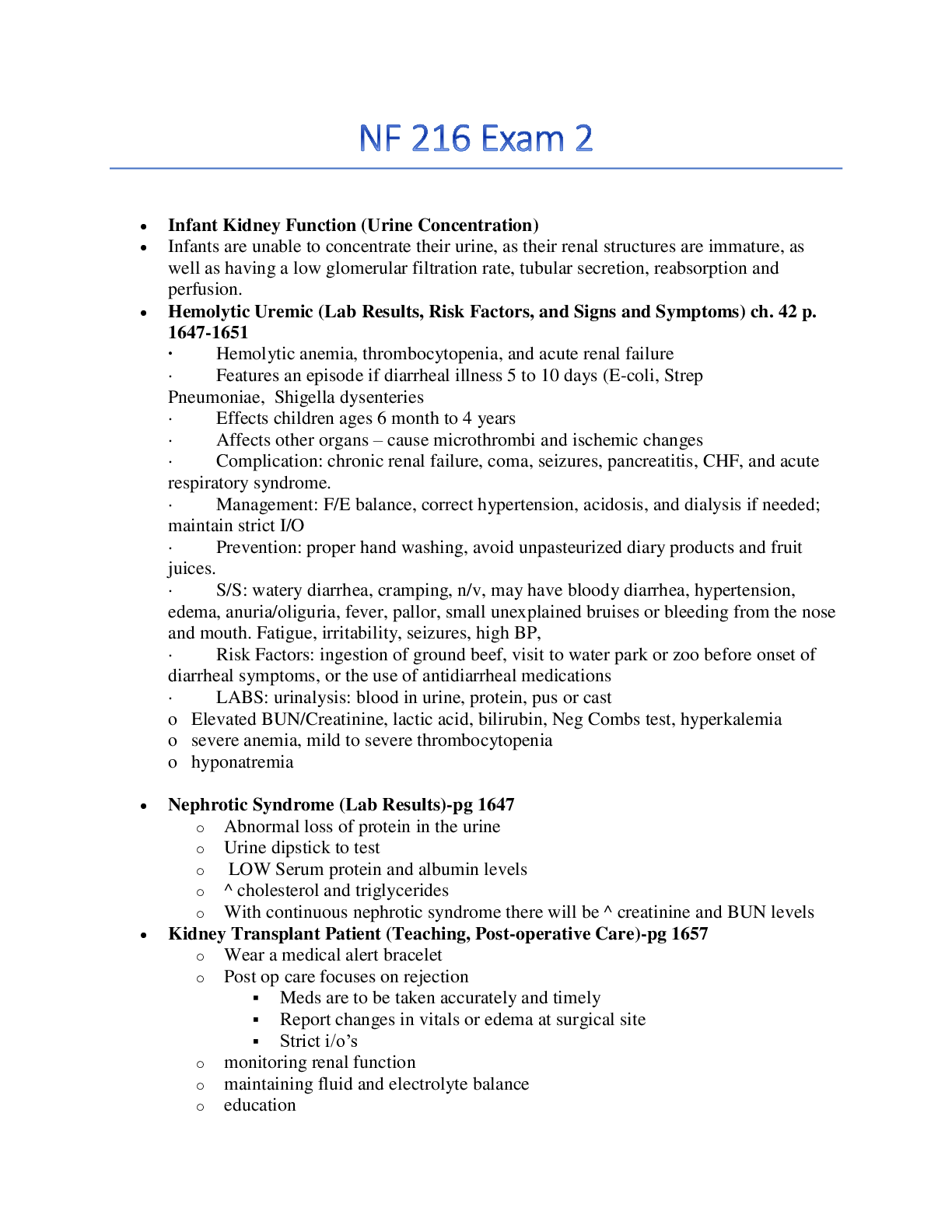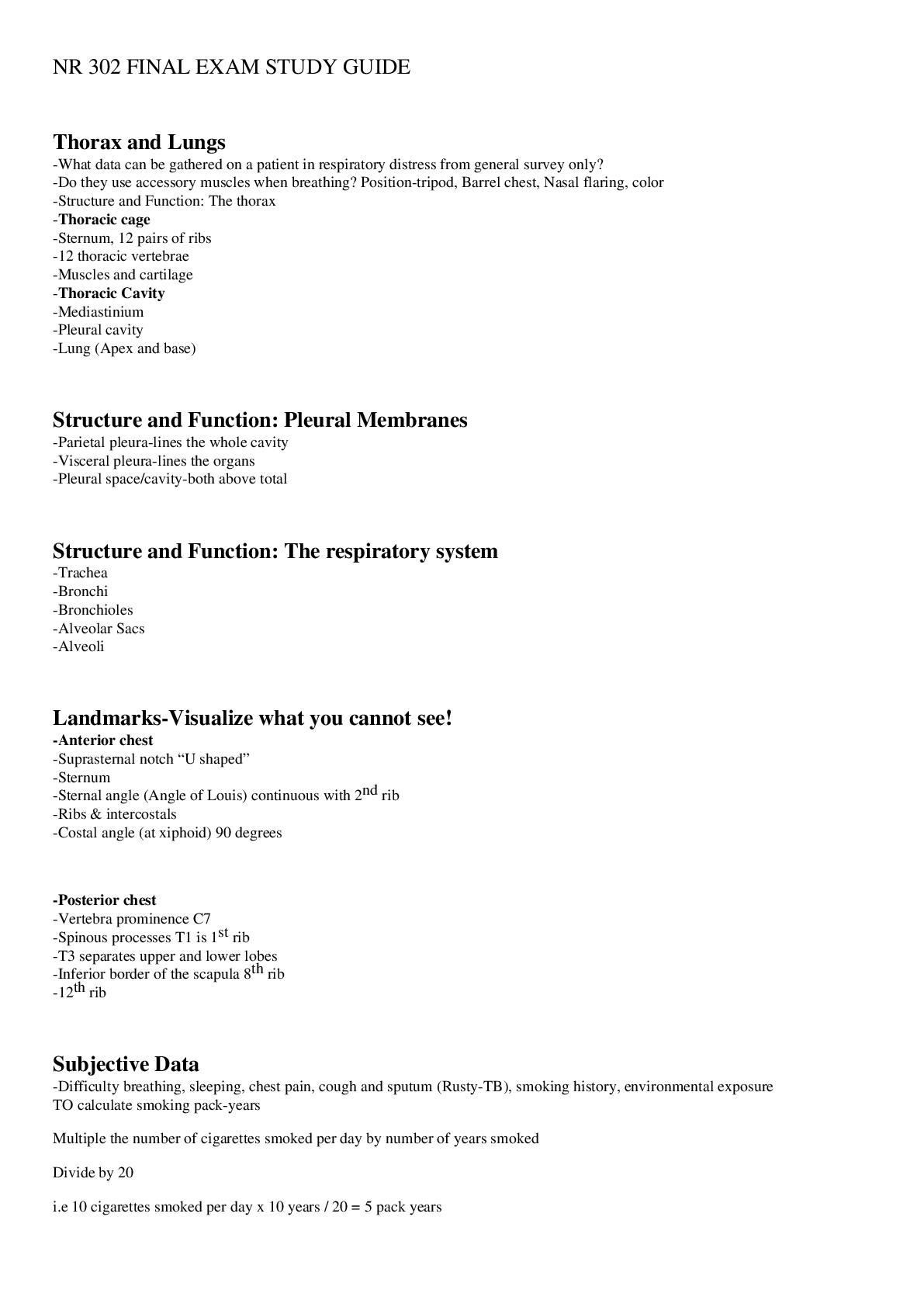*NURSING > STUDY GUIDE > Final REVISED Final Exam Study Guide Patho Spring 2020 (All)
Final REVISED Final Exam Study Guide Patho Spring 2020
Document Content and Description Below
Final Exam Concept Guide Know the Etiology, Signs/Symptoms, Diagnosis/Diagnostics, Clinical Manifestation, Risks, Treatment and Complications for the following: Gastritis Gastritis – inflamm... ation of the stomach lining Acute Gastritis – (just acquired) ingestion of toxins, alcohol, aspirin or other irritating substances Chronic- 2 months to become chronic Triggers of Gastritis: Alcohol, caffeine, autoimmune disease, viral or bacteria Chronic Gastritis: H Pylori is always a factor H Pylori goes very deep in the lining of the stomach and It causes persistent inflammation S/S: N/V – Anorexia- postcranial discomfort Post Cranial Discomfort- after eating- goes away and come back 1-2 hrs Gastritis- hematemesis- blood in the vomit- coffee brown color Treatment: Treat H pylori treat GERD, change lifestyle, PPI Peptic Ulcer Disease Inflammation and ulceration in the stomach (acid and pepsin) Gastric: stomach location Duodenal: duodenal location PUD is a complication of Gastritis PUD is caused by aspirin, H pylori, Nsaids, Stress, Smoking S/S Gastric N/V Anorexia Chest discomfort, asymptotic, Dyspepsia Duodenal – normal weight Biggest complication of PUD- GI bleeding due to Ulcer perforation- hole in the lining and bleed It is life-threatening if it keep bleeding (Anemic, electrolytes imbalance (losing volume) Duodenal – Blood in the stool – black and tarry Bleeding profusely-frank with cloth Hematemesis- Bleeding in vomiting Treatment: Cortery of perforation, treatment of H. pylori, PPI, Cessation of smoking Ulcerative Colitis and Crohn’s the difference in the complications Complication in UC Malnutrition – dehydration, increased risk factor of colon cancer 7-10 yrs, rarely in megacolon Complication of Chron- Fistulas, perianal fissures, abscesses. The risk of colorectal cancer Bowel Obstruction Manifestations Obstructions in the jejunal area: Vomiting, dehydration, electrolyte depletion Obstructions of the distal portion of the small bowl or ileum, dehydration to hypovolemic schock Obstructions of the colon: Massive gas distention Blockage of the colon by a tumor is the most common cause of colonic obstruction and perforation of the bowel wall adjacent to the tumor. What percentage of the pancreas is dedicated to endocrine functions? Only 5% Pancreatic Cancer Pancreatic Cancer – 2% of all cancers Ranked 4th among death in all malignancies Risk Factors; cigarette smoking, obesity S/S; head: Jaundice, malabsorption, weight loss tail: Abd pain, nausea’ Hepatic Encephalopathy is due to? Hepatic encephalopathy is a decline in brain function due to severe liver disease Hepatic encephalopathy is usually precipitated by certain well-defined clinical developments, including hypokalemia, hyponatremia, alkalosis, hypoxia, hypercarbia, infection, use of sedatives, GI hemorrhage, protein meal gorging, renal failure, and constipation. In some patients, progressive liver failure leads to chronic encephalopathy without other exacerbating factors. Hepatic encephalopathy is graded 1 to 4: Grade 1: Confusion, subtle behavioral changes, no flap Grade 2: Drowsy, clear behavioral changes, flap present Grade 3: Stuporous but can follow commands, marked confusion, slurred speech, flap present Grade 4: Coma, no flap Gastroesophageal Varices Management - Initial treatment: Fluid resuscitation to stop bleeding - Large bore intravenous lines are placed - Admin of parenteral vitamin K and plasma, platelet infusion if thrombocytopenia is present - Octreotide acetate (synthetic analog) no more vasopressin 3-5 days - Metoclopramide and B blockers - Esophagogastroduodenoscopy EGD to determine site of bleeding Difference between Diverticulosis and Diverticulitis Diverticulosis (diverticular disease) presence of diverticula in the colon. Diverticula are acquired herniations of the mucosa and submucosa through the muscular coat of the colon Diverticulosis The presence of one or more diverticula vs diverticulitis inflammation of one or more diverticula Kidney Disease- Assessment-CVA Pain associated with intrarenal disorders are assessed by palpating or light percussion over the costovertebral angle (CVA) posteriorly and is recorded as CVA tenderness. Pain is transmitted to the spinal cord between T10 and L1 Kidney Cancer signs and symptoms Benign renal neoplasm: S/S Hematuria and flank pain Some may be asymptomatic until large Renal cell carcinoma: Metastatic disease Risk factors: smoking, obesity and hypertension S/S CVA tenderness, hematuria, palpable mass Dialysis- Benefits and Risks Filter blood and rid the waist Dialysis is the only therapeutic option for those with ESRD unable to obtain transplant Each treatment of dialysis remove about 2/3 of the total body urea content Dialysis maintain volume status Prevent and treat acid-base and electrolyte disturbances Prevent and treat uremia Support nutritional needs. Prevent and treat infection Orevent and treat anemia Improve quality of life Lower mortalty and morbidity rates Control pains VS RISKS Electrolytes imbalance (potassium and sodium) -need to check hyper or hypo Low blood pressure (have to check vitals before and after) Risk for infection Long-term mobidity Life threatening Cardiovascular disease remained the most common cause of death in ESRD patient Acute Kidney Injury- Three phases- Prodromal- Oliguric- Postoliguric Prodomal Phase - Normal or declining urine output - Serum blood urea nitrogen (BUN) and creatine levels rise Oliguric phase (10-14 days) range from 1 day to 8 weeks - Oliguria – Small abnormal amount of urine - Edema, Hypertension, Hypervolemia - Distended neck veins, weight gain - Crackles, possibly heart faily - WBC and RBC in urine - Protein in urine - Hyperkalemka - Volume overload - Azotemia and uremia - Metabolic acidosis Postoliguric phase (5% recover) - Fluid volume deficit - Labs begin to normalize - Polyuria – sodium waste Acute Tubular Necrosis and the causes of Acute Tubular Necrosis ATN is the result of tubular cell injury - Ischemia: Exposure to nephrotoxic substances - ½ of all cases of AKI Nephrotoxins leading cause of ATN (aminoaglycosides, NSAIDS, amphotericin B, cisplatin, tetracycline. CI- AKI or Contrast-induced nephropathy Cystitis- signs and symptoms (inflammation of the bladder) no fever or flank pain If fever is present – Might be infection (UTI) Confusion Cloudy urine Frequency Urgency Dysuria Intrarenal Kidney Injury- Toxic causes of Box 28.1 Ty pe s o f A c u t e K i d ney I n j u r y Prerenal • Absolute decrease in circulating volume o • Hemorrhage o • Dehydration o • Burns • Relative decrease in circulating volume [Show More]
Last updated: 1 year ago
Preview 1 out of 27 pages
Instant download
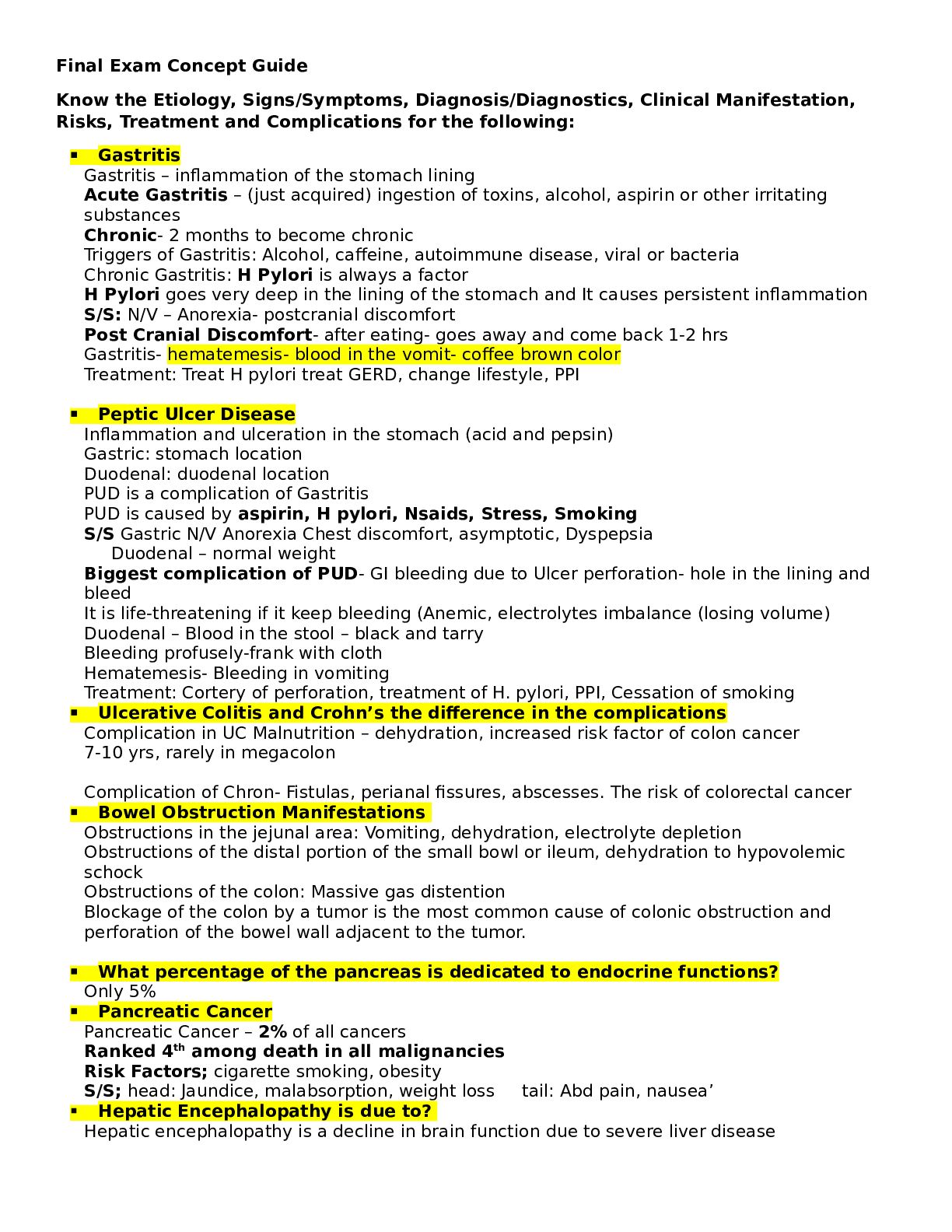
Buy this document to get the full access instantly
Instant Download Access after purchase
Add to cartInstant download
Reviews( 0 )
Document information
Connected school, study & course
About the document
Uploaded On
Aug 20, 2021
Number of pages
27
Written in
Additional information
This document has been written for:
Uploaded
Aug 20, 2021
Downloads
0
Views
36

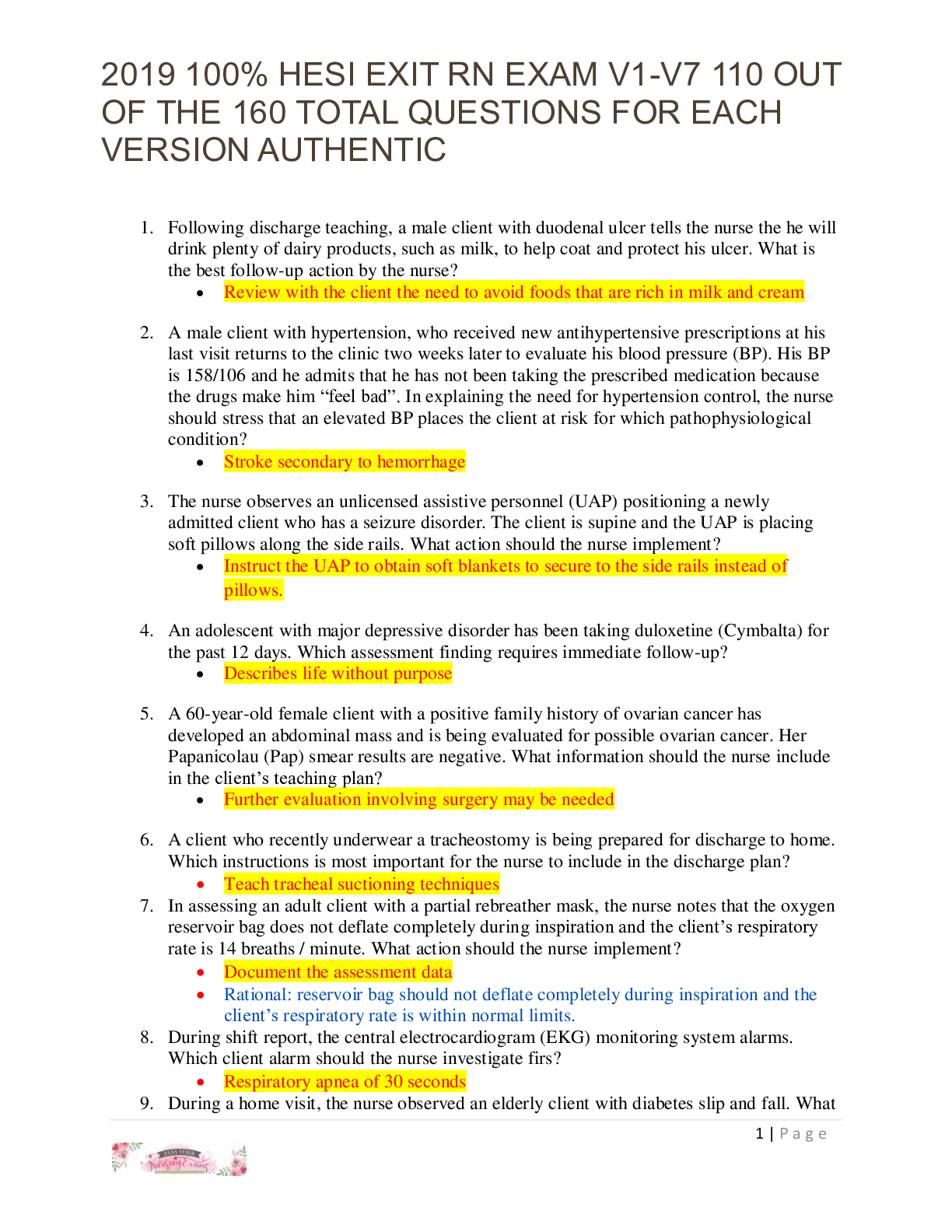

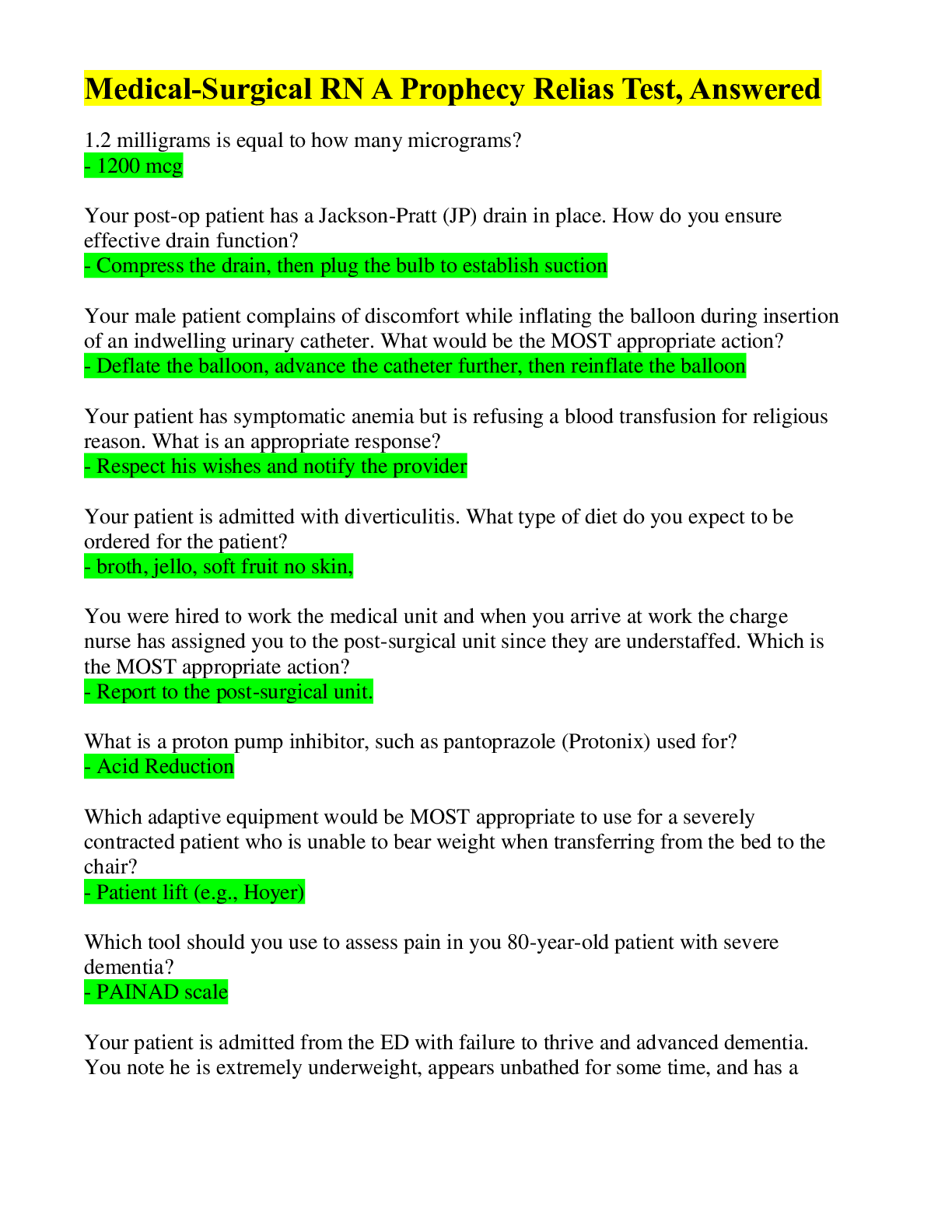

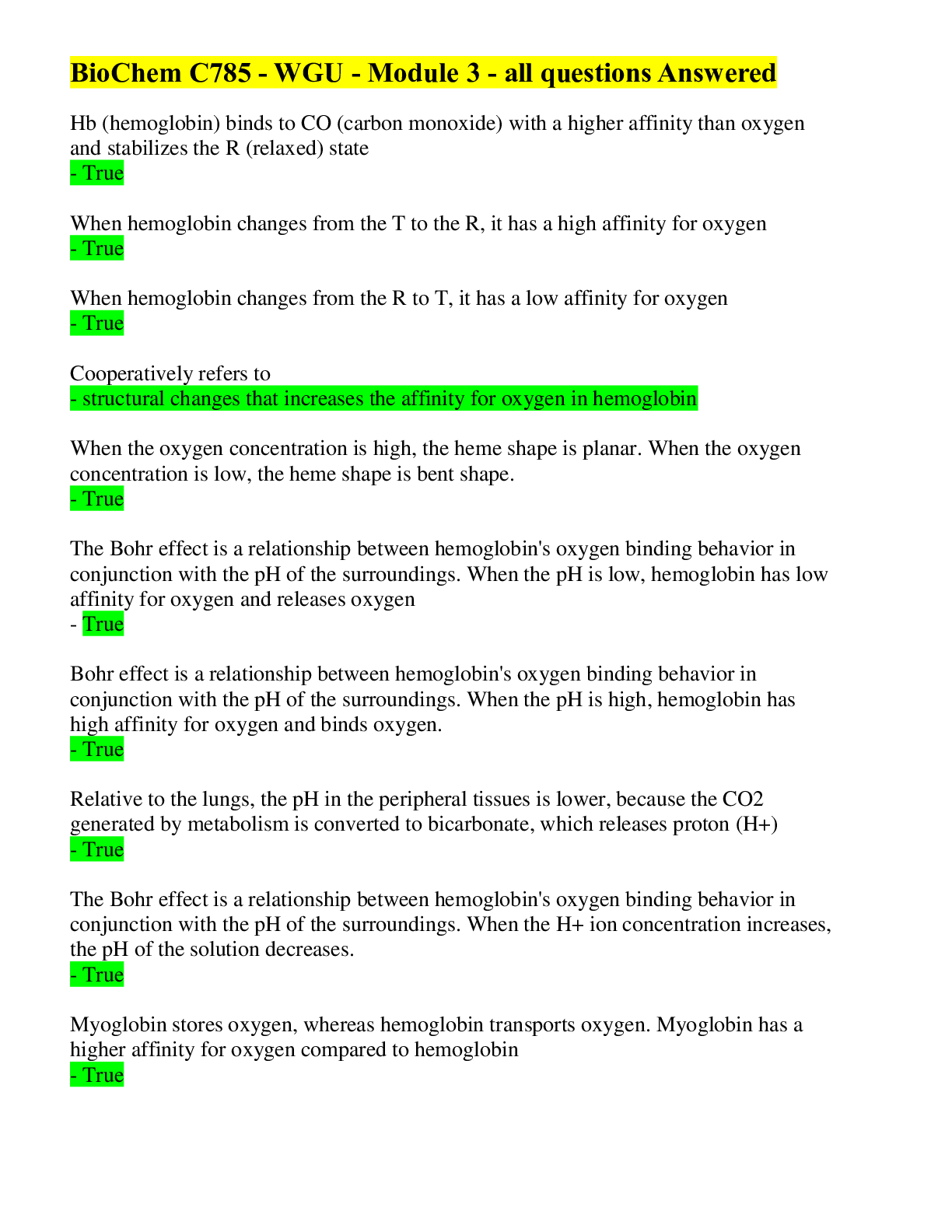


.png)
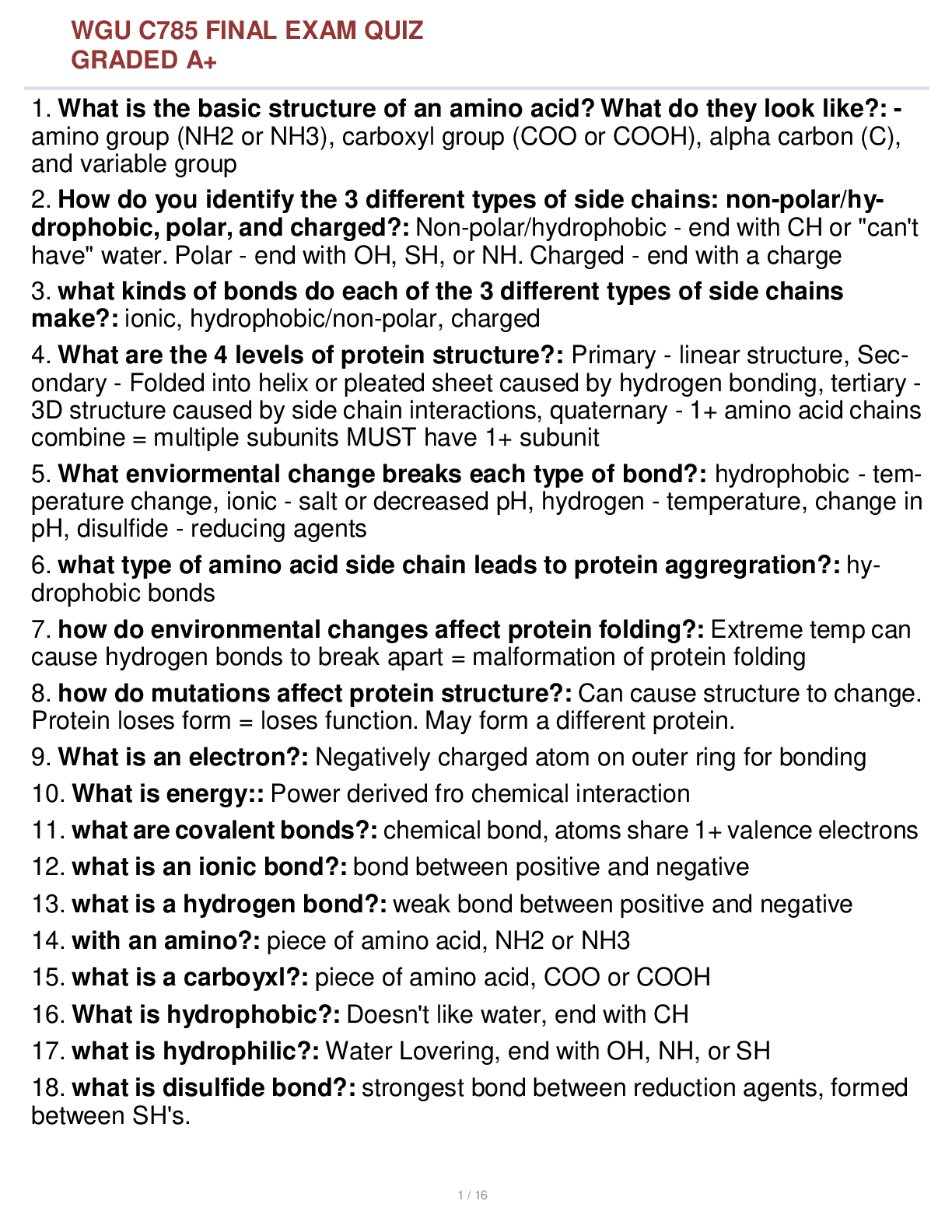
.png)
